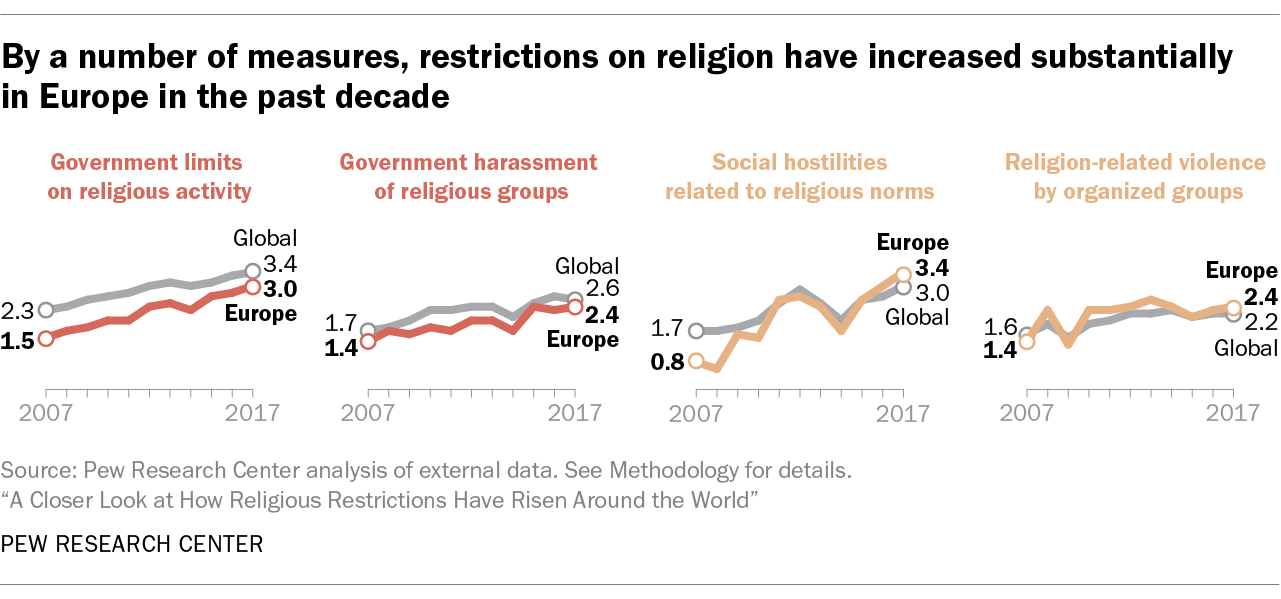From national laws regulating religious dress to local laws banning public worship by Muslims, religious restrictions have in recent years become more common in Europe. Indeed, while the Middle East-North Africa region had the highest levels of religious restrictions in the world, Europe saw some of the biggest increases over the last decade in certain types of restrictions.
These findings come from a recent Pew Research Center report that analyzes restrictions on religion (by both governments and private individuals or social groups) from 2007 to 2017. The report measures various types of government restrictions and social hostilities across eight different categories on a scale from zero to 10.

In one of these categories – government limits on religious activity – Europe’s score doubled over a 10-year period. This was one of the largest increases in any of the five global regions analyzed. (An explanation of the methodology is available here.)
A number of factors contributed to Europe’s higher score in this category. To begin with, numerous European countries and cities have banned people from wearing religious symbols or religious clothing, either completely or in certain circumstances (such as at public service jobs or photographs for official documents). For example, France in 2011 outlawed full-face coverings, preventing Muslim women from being able to wear the burqa or niqab in public. And in Spain in 2010, several cities in Catalonia banned the burqa and niqab, as well as face-covering veils, in public buildings.
Other government actions also raised Europe’s score in this area. In 2012, several local councils in Moldova banned public Muslim worship. And in Germany, a court in Cologne classified circumcision as assault when not done for medical purposes. After protests from Jewish and Muslim groups, the federal government passed legislation allowing the practice for religious reasons.
Europe’s score also rose sharply in the category of government harassment of religious groups. In one year of our analysis, 2015, religious groups in 38 out of 45 European countries reported at least limited levels of harassment. Some of these incidents related to the increase in immigrants to Europe. For instance, Dutch parliamentarian Geert Wilders campaigned against the growth of Muslim populations in the West, lamenting what he called “a tsunami of refugees from Islamic countries who threaten our women and our civilization.”
In addition to government actions, there also was a dramatic increase in Europe in some measures of social hostility to religion. Europe’s score in the category of social hostilities related to religious norms increased by a factor of four over a decade, exceeding the global average. The number of European countries reporting individual or group violence or threats of violence aimed at forcing people to adopt religious beliefs or practices different than their own rose from four to 15 (out of 45 European countries) over the decade studied.
Examples of this kind of harassment include a case in 2015 in Ukraine, where four Jehovah’s Witnesses were held at gunpoint, beaten and forced to confess Orthodox Christianity as the only true religion. In 2016 in the United Kingdom, a Sunni Muslim killed an Ahmadi Muslim for allegedly disrespecting the Prophet Muhammad. And in Germany, religious groups reportedly used the fear of deportation to encourage thousands of refugees to convert to Christianity.
There also was an increase in Europe over the decade in the category of religious hostilities by organized groups. The number of European countries where organized groups used force or coercion to promote their perspective on religion rose during this period from 21 to 33. These incidents included not only multiple attacks by those pledging allegiance to the Islamic State, but also cases such as one in Finland, where a neo-Nazi group called the Nordic Resistance Movement published anti-Jewish and anti-Muslim materials and organized rallies. The group also coordinated antireligious activities in Sweden in 2017.
Of eight categories we measured, the only one where Europe saw a decline in restrictive activity was in the measure of interreligious tension and violence. This also was the only category for which the global average declined.
